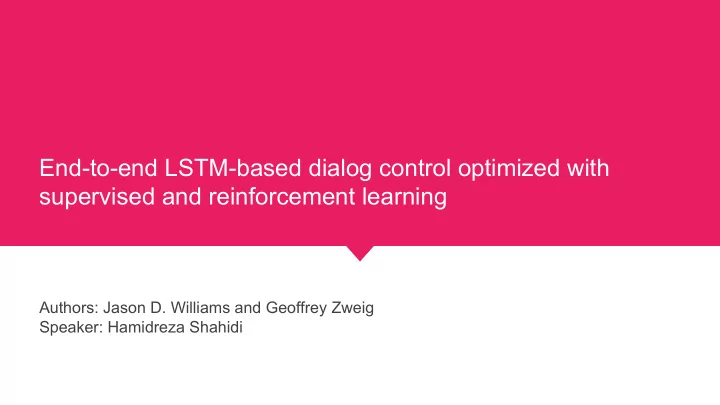

End-to-end LSTM-based dialog control optimized with supervised and reinforcement learning Authors: Jason D. Williams and Geoffrey Zweig Speaker: Hamidreza Shahidi
Outline ● Introduction ● Model description ● Optimizing with supervised learning ● Optimizing with reinforcement learning ● Conclusion
Task-oriented dialogue systems A dialog system for: ● Initiating phone calls to a contact in an address book ● Ordering a taxi ● Reserving a table at a restaurant
Task-oriented dialogue systems A dialog system for: ● Initiating phone calls to a contact in an address book ● Ordering a taxi ● Reserving a table at a restaurant
Reinforcement learning Setting State = (user’s goal, dialogue history) Text actions “Do you want to call <name>?” Actions = API calls PlacePhoneCall(<name>) Reward = 1 for successfully completing the task, and 0 otherwise
Reinforcement learning Setting State = (user’s goal, dialogue history) Text actions “Do you want to call <name>?” Actions = API calls PlacePhoneCall(<name>) Reward = 1 for successfully completing the task, and 0 otherwise
Model description
Model
User Input
Entity Extraction For example: identifying “Jason Williams” as a <name> entity
Entity Input For example: Maps from the text “Jason Williams” to a specific row in a database
Feature Vector
Recurrent Neural Network LSTM neural network is used because it has the ability to remember past observations arbitrarily long.
Action Mask If a target phone number has not yet been identified, the API action to place a phone call may be masked.
Re-normalization Pr{masked actions} = 0 Re-normalize into a probability distribution
Sample Action RL: sample from the distribution SL: select action with highest probability
Entity Output
Taking Action
Training the Model
Optimizing with supervised learning
Prediction accuracy ● Loss = categorical cross entropy ● Training sets = 1, 2, 5, 10, and 20 dialogues ● Test set = one held out dialogue
The model is rebuilt. The current model is run on unlabeled instances. Active Learning The unlabeled instances for which the model is most uncertain are labeled.
Active learning ● For active learning to be effective, the scores output by the model must be a good indicator of correctness. ● 80% of the actions with the lowest scores are incorrect. ● Re-training the LSTM is fast Labeling low scoring actions will rapidly improve the performance.
Optimizing with reinforcement learning
Policy gradient Dialog history at time t Return of the dialogue Weights of the LSTM The LSTM which outputs a distribution over actions
RL Evaluation
Conclusion 1. This paper has taken a first step toward an end-to-end learning for task-oriented dialog systems. 2. The LSTM automatically extracts a representation of the dialogue state (no hand-crafting). 3. Code provided by the developer can enforce business rules on the policy. 4. The model is trained using both SL & RL.
Thank you
Recommend
More recommend